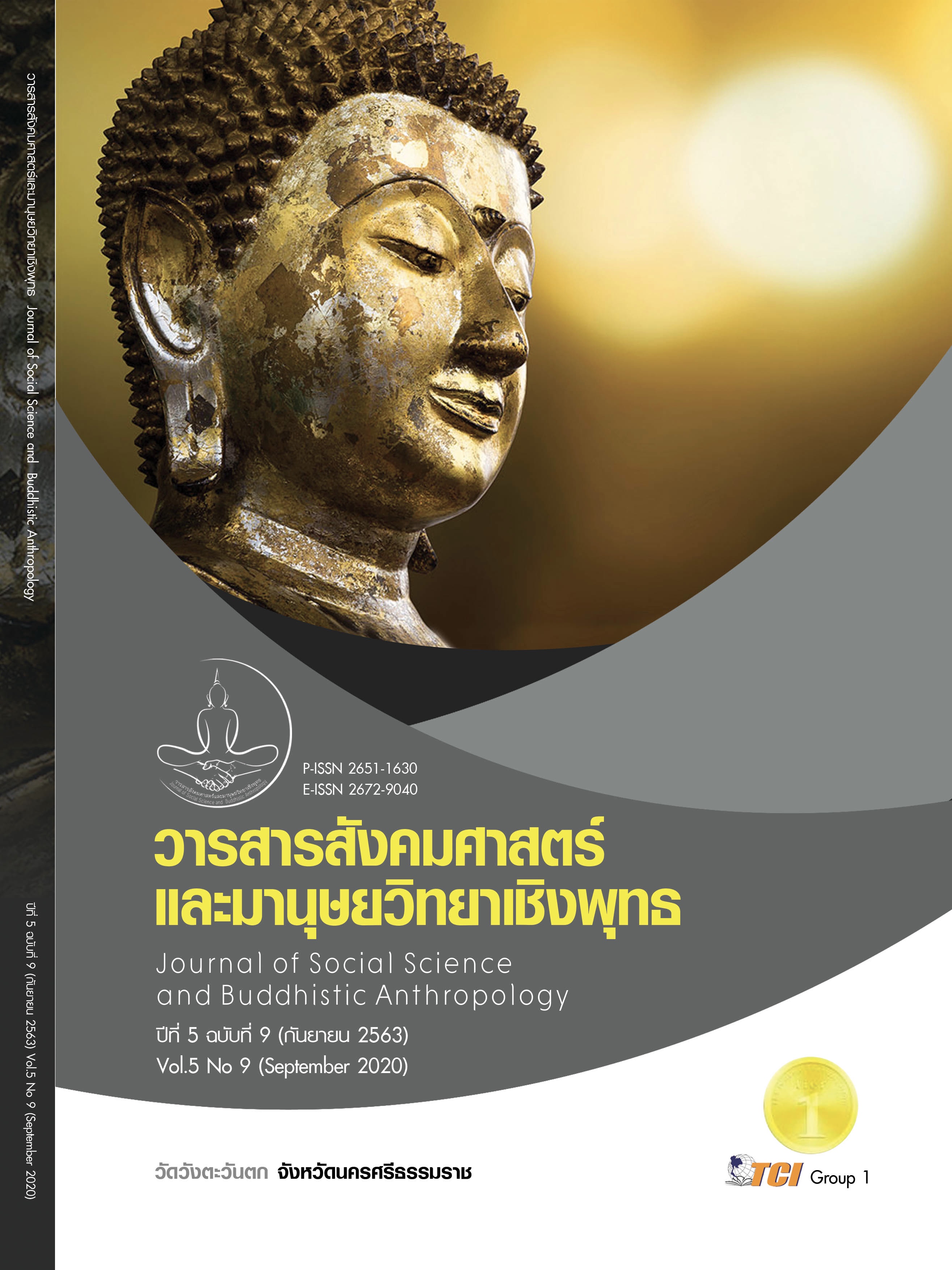DEVELOPMENT OF PLAY ACTIVITIES MODEL FOR THE LEARNING ENHANCEMENT OF SIXTH GRADE STUDENT IN SCHOOL UNDER THE DEPARTMENT OF EDUCATION BANGKOK
Keywords:
Play Activities Model, Learning Enhancement, Sixth Grade StudentAbstract
The purposes of this article were: 1) to study the needs organization of recreation activities for playing; 2) the development of a play activities model; and 3) to study the effectiveness of this model to enhance learning development for sixth grade students. The researcher collected data from the demand questionnaire. The organization of recreation activities to play at sixth grade students, amount 662 people in schools under the Education of Bangkok of the academic year 2018 purposive sampling and stratified sampling and a group conversation from 15 experts and the test of playing skills. By analyzing the content, mean and standard deviation. The result showed: 1) It was found that though watching movies and cartoons that the students had the highest level of needs, with mean of 5.00 and a standard deviation of 0.00; Craft activity with mean of 4.89 and a standard deviation of 0.11; Plasticine molding activities had mean of 4.83 and a standard deviation of 0.16; 2) creating of playing model should be fun, challenging, exciting interesting and active play that the objective, of the activity can be evaluated in the cognitive domain, affective domain, and psychomotor domain. Process activities are required in order consisting of brain exercise, group dynamic, play activity, wrap up, respectively. Evaluation by means of observation and assessment methods in 3 areas: knowledge, process and attitude. 3) the researcher experimented with the effect of playing styles by purposive sampling 30 students from Wat Lat Pla Khao School. After participating in 8 weeks of various style of the students who participated had higher scores. All of the aspects consisted of the cognitive domain, affective domain and psychomotor domain and compared to before the trial had a statistical significance of .05.
References
กลัญญู เพชรากรณ์. (2561). จิตวิทยาครูสำหรับการจัดการเรียนรู้. เรียกใช้เมื่อ 14 มกราคม 2561 จาก http://www.eledu.ssru.ac.th /kalanyoo_pe/file.php/4/_6_.pdf.
กองออกกำลังกายเพื่อสุขภาพ กรมอนามัย. (2561). การขยับเคลื่อนไหวและยืดเหยียดร่างกาย. เรียกใช้เมื่อ 10 ธันวาคม 2561 จาก http://dopah.anamai.moph.go.th/?page _id=78.
เกษม นครเขตต์. (2558). ประสบการณ์การเรียนรู้จากการเล่นของเด็ก ตามองค์ประกอบ Bloom s Taxonomy. วารสารสุขศึกษา พลศึกษา และสันทนาการ, 41(2), 31-37.
เกษมสันต์ พานิชเจริญ. (2559). การพัฒนารูปแบบการประเมินในการจัดการเรียรู้พลศึกษา สำหรับนักเรียนระดับชั้นมัธยมศึกษาปีที่ 3. ใน ดุษฎีนิพนธ์การศึกษาดุษฎีบัณฑิต สาขาวิชาสุขศึกษาและพลศึกษา. มหาวิทยาลัยศรีนครินทรวิโรฒ.
คณะกรรมการส่งเสริมการพัฒนาเด็กและเยาวชน. (2561). แผนพัฒนาเด็กและเยาวชนแห่งชาติ ฉบับที่ 2. กรุงเทพมหานคร: โรงพิมพ์ เจ เอส การพิมพ์.
คณะนิเทศศาสตร์ มหาวิทยาลัยรังสิต. (2559). การจัดทำมาตรฐานจริยธรรมและผลิตรายการโทรทัศน์. เรียกใช้เมื่อ 10 ตุลาคม 2562 จาก https://broadcast.nbtc.go.th /data/academic/file/600100000001.pdf.
ทิศนา แขมมณี. (2553). ศาสตร์การสอน องค์ความรู้เพื่อการจัดกระบวนการเรียนรู้ที่มีประสิทธิภาพ. (พิมพ์ครั้งที่ 12). กรุงเทพมหานคร: สำนักพิมพ์จุฬาลงกรณ์มหาวิทยาลัย.
ปิยนันท์ พูลโสภา. (2560). การพัฒนาการเล่น เพื่อการเรียนรู้ของเด็กปฐมวัยในศตวรรษที่ 21. วารสารศึกษาศาสตร์ปริทัศน์, 32(1), 20 – 27.
พระมหาสมยศ เพียสา. (2553). การศึกษาและพัฒนาแรงจูงใจในการเรียนวิชาพระพุทธศาสนาของนักเรียนช่วงชั้นที่ 3 โดยใช้กิจกรรมกลุ่ม. ใน วิทยานิพนธ์การศึกษามหาบัณฑิต สาขาวิชาจิตวิทยาการแนะแนว. มหาวิทยาวิทยาลัยศรีนครินทรวิโรฒ.
พิชิต เมืองนาโพธิ์. (2558). ความสามารถทางกาย. วารสารคณะพลศึกษา มหาวิทยาลัยศรีนครินทรวิโรฒ, 18(1), 5-6.
วรดนู จีระเดชากุล. (2551). ปรัชญา แนวคิดเกี่ยวกับ เวลาว่าง การเล่น และนันทนาการ (พิมพ์ครั้งที่ 5). กรุงเทพมหานคร: สำนักพิมพ์แห่งจุฬาลงกรณ์มหาวิทยาลัย.
สำนักการศึกษา กรุงเทพมหานคร. (2562). รายงานสถิติการศึกษา ปีการศึกษา 2562 โรงเรียนในสังกัดกรุงเทพมหานคร. กรุงเทพมหานคร: โรงพิมพ์มหาจุฬาลงกรณราชวิทยาลัย.
สำนักงานกองทุนสนับสนุนการสร้างเสริมสุขภาพ. (2562). Thailand’s2018 Report Card on Physical Activity for Children and Youth. เรียกใช้เมื่อ 5 กันยายน 2562 จาก https://www.thaihealth.or.th
สำนักบริหารและพัฒนาองค์ความรู้. (2561). แนวทางการจัดการเรียนรู้ตามหลักการพัฒนาสมอง สำหรับเด็กวัย 7-12 ปี. กรุงเทพมหานคร: บริษัท พลัสเพรส จำกัด.
สุชีวา วิชัยกุล. (2559). การพยายาบาลเด็กที่มีปัญหาผื่น. เรียกใช้เมื่อ 10 ตุลาคม 2562 จาก https://docuri.com/download/skin_59c1cc95f581710b28620215_pdf
สุรศักดิ์ อาภาสกุล. (2562). Play Day วันเล่นสนุก เล่นเปลี่ยนโลก. เรียกใช้เมื่อ 24 กันยายน 2562 จาก https://www.thaihealth.or.th /Content/50151-Play%20Day
Bloom, B. S. (1976). Human characteristics and school learning. New York: McGraw-hill.
Erik, H. E. (1950). Childhood and Society. Science, 113(2931), 253 - 260.
Freyberg, J. T. (1973). Increasing the Imaginative Play of Urban Disadvantaged Kidergarten Children Through Systematic Training . In The Child's World of Make-beleeve. J.L. Singer. New York: Academic Press.
Humphrey, J. H. (1990). Helping Learning-disabled gifted children learn through compensatory active play. the United states of America: Charles C: Thomas.








